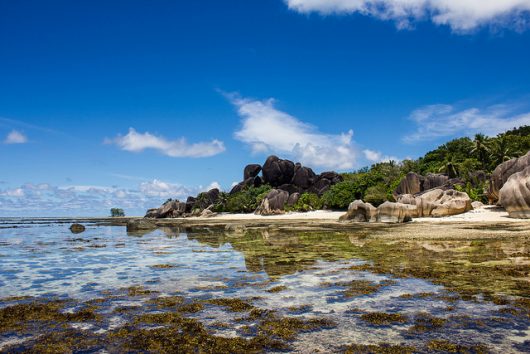Water Quality in Seychelles

The Republic of Seychelles is an archipelago of 115 low-lying, granitic islands in the western Indian Ocean. This sovereign country is a popular holiday getaway for tourists wishing to lounge on its stunning beaches; discover its diverse ecological system; and visit ancient volcanos. Water quality in Seychelles remains a major issue, however.
Though the Republic’s 1993 Constitution defines access to potable water as a basic right to all Seychellois, water shortage and pollution is a defining factor of the archipelago.
While local tap water meets World Health Organization’s specifications, the Seychelles Islands official tourism website advises visitors to drink bottled water because the chlorinated tap water may not be safe to drink. Furthermore, because water quality in Seychelles is variable in undeveloped areas, it is recommended that tap water be boiled, filtered or chemically disinfected before consumption.
The islands’ groundwater resources are extremely limited, and the terrain makes it even harder to procure fresh water. Due to the country’s prevailing granitic landscape, water that is available is often too hard and salty to consume.
Of course, rapid change in weather and rainfall patterns is a global phenomenon and is not uncommon to Seychelles. Shifting weather patterns directly affect the water supply and reduce the precious steam flow, making it difficult for groundwater to recharge.
Most of the water in Seychelles comes from hills and streams from the mountainside, flowing more freely during monsoon and rain seasons. As a result of heavy rainfall, storm surge, flooding and poor sanitation, the presence of water-related bacterial infections—including Campylobacter jejuni, small strains of E.coli, cholera and other contaminants—in the country’s water supply can cause traveler’s diarrhea, a term used to describe gastrointestinal infections caused by ingesting bacteria, viruses and protozoa.
Four desalination plants compensate for the water shortage during drier seasons and produce potable water. They help enhance water reliability of the three main islands. The country is not only managing its scarce water resources, but it is also searching for more water. Of course, water quality in Seychelles remains an accompanying concern.
Options such as drilling for underground water are currently being explored to supplement the existing surface water (usually accumulating on slippery rock fissures if not running off to sea) and add to the water supply of dams and desalination plants.
In November 2009, the Seychelles National Climate Change Committee embarked on an ambitious vision to engage all levels of the Seychellois society in combating the potentially disastrous effects of climate change.
The committee recognized that water resources in islands as small as Seychelles were “likely to be seriously compromised”—both due to growing demand and climate change —and predicted that Seychelles would be facing “serious water shortages in the near future.”
This was despite the presence of extensive water distribution networks that served about 87% of the population with treated water. Furthermore, an increase in surface air temperatures would result in reduced streamflow due to water evaporation and further exacerbate the problem of water supply.
By 2030, the water demand on the main island of Mahé is expected to grow by 130%. Currently, Seychelles can only meet 60% of its residents’ water.
Earlier this month, a ban on manufacturing, distribution and commercial usage of common plastic items—such as Styrofoam containers, utensils and cups—went into effect in an attempt to make Seychelles cleaner and more beautiful.
The Environmental Protection Regulations of 2017 restrict the importation of certain types of plastic bags and authorize importation permits for biodegradable bags. Treatment of wastewater is being upgraded through renovations of existing sewerage pumping stations and construction of five new ones, with a Sanitation Master Plan currently in the works.
Furthermore, a new Center for Ocean Restoration, Awareness and Learning (CORAL) opened in May 2017 on the island of Praslin to study, brainstorm ideas and increase awareness of the ocean-conservation efforts by bringing scientists and students together from all over the world.
Seychelles is the smallest African state, with only about 84,000 people. Its sustainable tourism model remains an example for the rest of the world. As the archipelago comes to terms with its water shortage and pollution problems, reliable and sustainable water supply remains as essential as ever. If the water quality in Seychelles can be improved, the quality of life of residents and tourists—and their future generations—will only become better.
– Mohammed Khalid
Photo: Flickr
